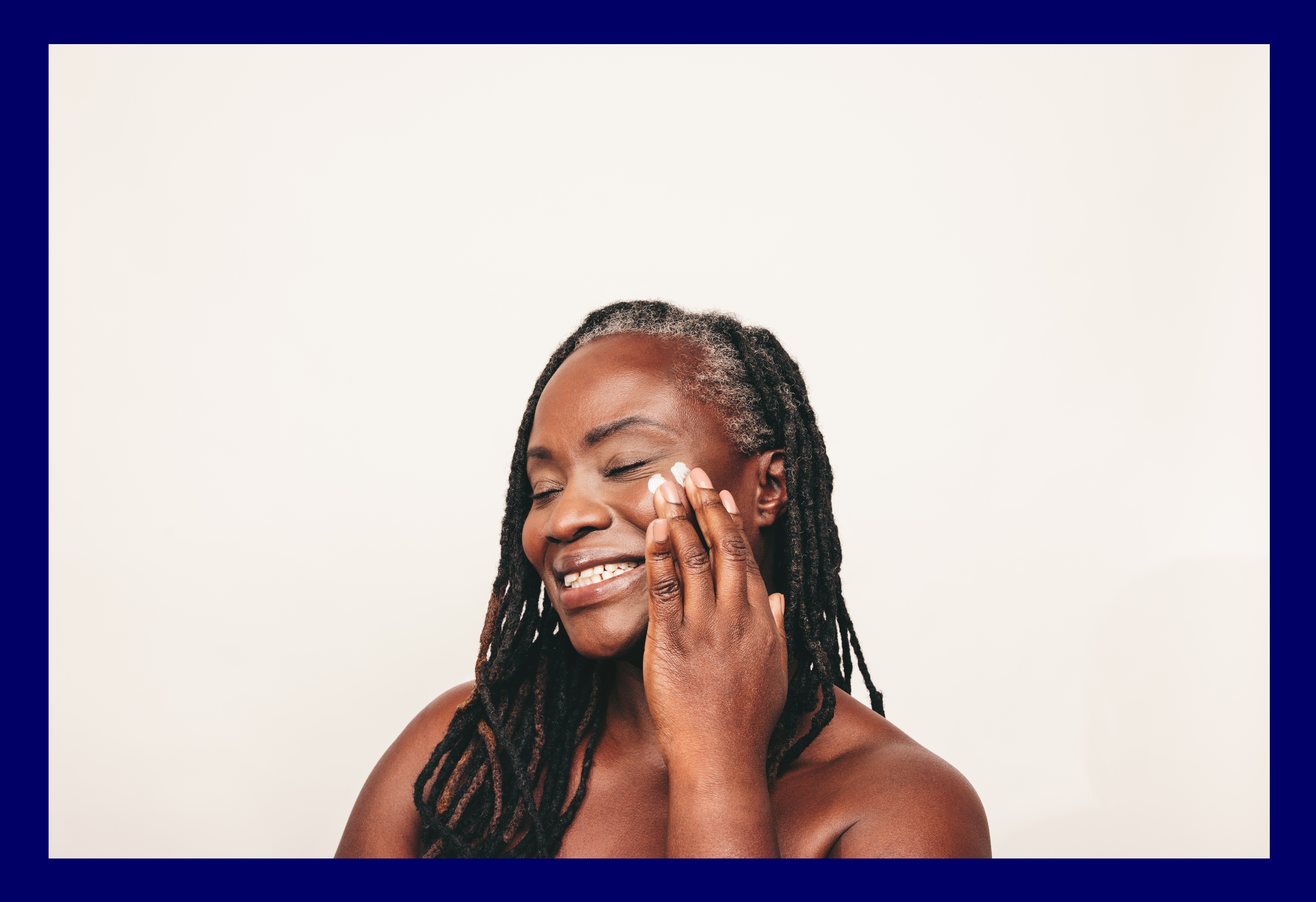
Published on Jul 29, 2024
Last modified on Sep 24, 2024
Wait…You Can Put Estrogen Cream On Your Face?
5 min read

If you’re on social media and in perimenopause, chances are you’ve seen something about the use of estrogen cream for menopausal and postmenopausal skincare. (Yes, that very same cream that’s usually used for vaginal symptoms). And believe it or not, there may actually be something to it…let’s take a look at the science behind this unconventional skincare regimen.
Menopause and our skin
When it comes to symptoms of menopause — hot flashes, vaginal changes, and irregular periods to name a few — estrogen is often the common denominator. But because skin has estrogen receptors, this hormone also affects the physiology of our skin cells, including our facial skin. (Seriously –– what doesn’t it affect?!) Estrogen’s skincare notable mentions:
- Provides skin elasticity and firmness
- Maintains skin thickness through the production of collagen (the building block of our skin that helps it maintain thickness, produce natural oils, and retain moisture)
- Helps skin maintain moisture through the production of sebum (an oily substance that forms a protective coating on our skin’s surface)
- Helps with wound healing
During perimenopause, the body’s production of estrogen begins to fluctuate and progressively decline. Lower estrogen levels mean less collagen and sebum production, which explains why many of us notice skin aging symptoms upon entering perimenopause:
- Skin dryness (and itching, which is called pruritus in doctor-speak) on our face, limbs, neck, chest, and back
- Decreased firmness
- Reduced elasticity
- Increased prominence of wrinkles
- Slower wound healing
- Worsening symptoms of eczema and rosacea
- The development of teenage-like acne (WTF!?)
- Growth of male-pattern facial hair along the upper lip, chin, and jawline (due to the impact of higher levels of testosterone relative to estrogen)
Not fun…this is where estrogen face cream can come in.
Benefits of using estrogen cream for skin care
Estradiol cream has historically been used for vaginal symptoms of menopause, many of which overlap with the facial skin changes we noted above and include vaginal dryness, irritability, and pain during sex. Topical vaginal estrogen, a low-dose estrogen cream applied topically, can help with these symptoms and doesn’t come with the same risks as systemic menopausal hormone therapy (MHT), which targets whole-body symptoms.
When applied to the face, topical estrogen can help by some of the same mechanisms that combat vaginal dryness, and is shown to:
- Increase collagen production
- Restore skin moisture
- Improve skin firmness and elasticity
- Increase hyaluronic acid
- Decrease wrinkle depth and pore size
What’s the difference between estradiol and estriol cream?
Estriol and estradiol are two main types of estrogen offered on a prescription basis, both of which are bioidentical — meaning their chemical structure is the same as estrogen produced in the ovaries. Estriol is another slightly weaker form of estrogen that is only available for prescription through compounding pharmacies, meaning the topical estriol medications available aren’t FDA-regulated like estradiol.
For the purposes of skincare, one option is to use compounded estriol cream, which can be made with other ingredients found in high quality skincare products, such as hyaluronic acid. However, since these can be pricey, another method is to use a small amount of vaginal estradiol and apply it directly to facial skin targeting areas like crows feet or “11 lines.”
Can I use it if I’m already using MHT?
Unlike menopausal hormone therapy (previously referred to as hormone replacement therapy/HRT), topical estrogen therapy contains a low dose of the hormone and works locally. This means it doesn’t increase blood levels of estrogen, so it’s safe to use alongside MHT. Given its low systemic absorption, it’s also shown to be safe for those who previously had breast cancer.
Where can I get estrogen cream?
Currently, estrogen cream is available only by prescription in the U.S. If you are interested in trying it out, we recommend speaking with your healthcare provider or a dermatologist.
Alternatives to estrogen face cream
Not a candidate for estrogen face cream or looking for alternative skin care products? Not to worry — there are plenty of OTC and prescription opinions available including:
- Vitamin C: In addition to boosting our immune health, vitamin C is a powerful antioxidant — aka a naturally-occurring chemical that protects our skin from damage caused by free radicals. Plus, this vitamin helps boost collagen production!
- Hyaluronic Acid: This naturally-produced substance helps keep our skin hydrated and elastic.
- Retinol: This vitamin A-based anti-aging compound is used widely to minimize fine lines and wrinkles, and improve skin texture. Its concentrated form, Tretinoin, is available only via prescription as it can cause irritation in some people.
Whether you use estrogen face cream or the options outlined above, sunscreen is also an absolute must for both preventing skin damage and minimizing the harmful effects of the sun on our skin — these are our favorite brands.
And of course, we would be remiss not to stress the role of hydration and diet in maintaining healthy skin. As per usual, we suggest the Mediterranean diet, which is rich in antioxidants and anti-inflammatory, making it a great choice for overall wellness and skin health.
READ MORE:



